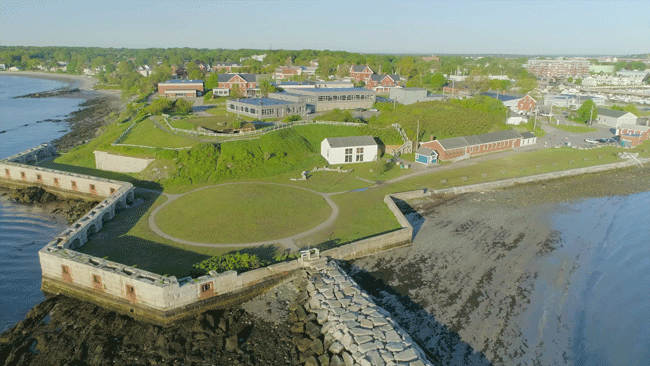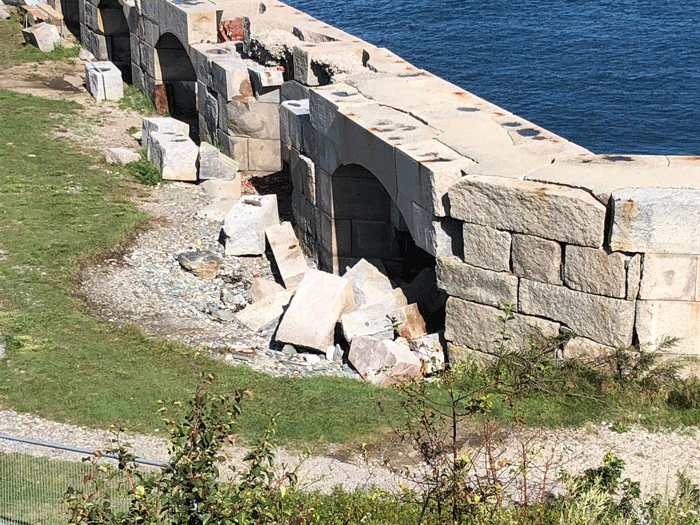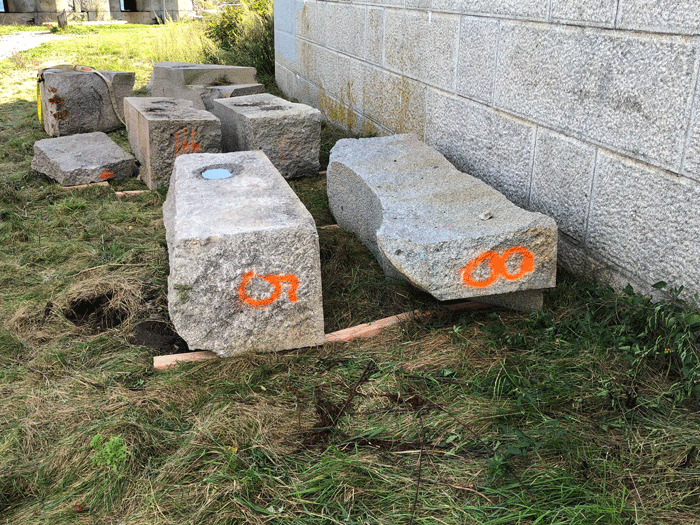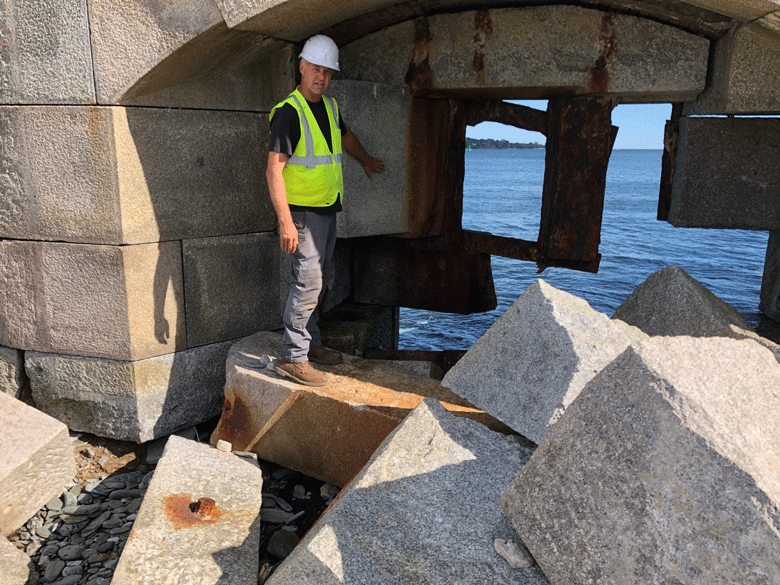
Workers have moved three-ton granite blocks and taken measures to mitigate erosion and improve drainage in an effort to stabilize Fort Preble, a historic fortress near the entrance to Portland Harbor that has endured for more than 200 years.
Dating back to 1808 and active in all major wars from the War of 1812 through World War II, Fort Preble today serves as a living reminder of Maine’s role in U.S. naval history and the abundance of historic forts that pepper the coast. But it has deteriorated in recent years from the weather and the sea, and it suffered substantial damage in a violent storm that pummeled the coast last December, dislodging and toppling over many of the fort’s granite blocks.
The fort is now part of the Southern Maine Community College campus in South Portland, which is spending about $200,000 on the stabilization project. Great Falls Construction of Gorham began the work in early September and was expected to finish by mid-October.
Aaron Bourassa, the project manager for Great Falls, said six granite blocks—each weighing roughly 6,000 pounds—were removed from atop the fort’s 19 casemates because they were unsafe. They have been labeled and set off to the side, ready to be reinstalled in the future when more funding becomes available.
“It used to be these were once-in-every 100 years storms. Now they’re every five years,.”
—Herb Adams
The job isn’t large, but it has its complexities. Bourassa and his crew have laid concrete to temporarily take the place of granite blocks that were washed out in the December storm, and to replace washed-out concrete in one location. They have installed underground piping and used riprap to ease erosion and help with drainage. They also reinforced some of the granite blocks by covering them with polyester fabric, over which they applied concrete; engineers designed it like this so when the concrete is removed in the future, it will break away clean rather than being stuck to the granite.
The fort was built to prevent cargo ships from leaving port and later to defend the harbor from enemy attacks in times of war. Today, it serves as a breakwater to protect the campus during high tides and storms. As Bourassa provided an overview of the project, waves crashed against the fort at high tide.

“It’s important to me,” said Bourassa, who lives nearby in South Portland. “All of the forts in this area important. They make Portland Harbor what it is.”
In announcing the project, SMCC interim President Tiffanie Bentley said SMCC is a steward of “this treasured landmark.” The project is a stopgap measure to make it safe and prevent further damage, but it would probably require millions of dollars—money that is not available—to restore the fort to where it should be, she said.
“We will do everything within our means to keep it from further degradation so that it remains a source of inspiration and education for students and visitors for years to come,” she said.
Fort Preble was built to help enforce the short-lived 1807 Embargo Act enacted by President Thomas Jefferson that prohibited U.S. ships from trading with the British and French. It was named after Navy officer Edward Preble, a Portland native who rose to the rank of commodore.
The fort was expanded through the decades and served as a military post in the War of 1812 against Britain, the Civil War, and up through World War II. The granite-block casemates at the edge of the ocean were erected during the Civil War, and many of the fort’s red-brick buildings are still used today by SMCC for offices and classrooms.
Deeming the fort and others like it obsolete, the federal government deactivated Fort Preble in 1950 and gave the property to the state of Maine. Two years later, the site became the home to the Maine Vocational Technical Institute, which later became SMCC. The fort is located next to the 900-foot breakwater leading to the Spring Point Ledge Lighthouse and is open for the public to explore.
It’s important to preserve Maine’s historical structures because they are part of the state’s heritage, said Herb Adams, a Maine historian and SMCC professor. Previous generations passed the forts along to us, he said, and it is incumbent upon us to do the same for future generations.
With climate change bringing more extreme weather and rising seas, coastal forts are under more pressure than ever, he said, as evidenced by the December storm that damaged parts of Fort Preble.
“It used to be these were once-in-every 100 years storms,” he said. “Now they’re every five years, or maybe every other year. Maine’s whole coast is in danger.”
A video of the December storm shows huge waves crashing into the fort with the ferocity of a boxer catching an opponent with a succession of vicious uppercuts.
“The British,” Adams said, “failed to do what Mother Nature did—knock over Fort Preble.”






